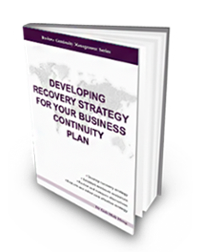The Optimal Business Continuity Strategy for an Entity is Determined by the
Before starting to develop the BC strategy, it is important to understand the overview of a typical disaster lifecycle. There are some basic questions that you will need to ask for each phase of the lifecycle. The BC strategy building block includes the formulation, selection and implementation of methods to reduce the impact of a disaster and to respond to incidents. Each strategy must: For any given plan, multiple strategies may be developed to address variations, including: For example, the BC strategy to resume operations from an outage during a peak production period may call for the use of a hot standby facility. An alternative strategy for the same facility or business operation in times of lower production demand could be to sub-contract or out-source the production. Depending on the scope of the plan, recovery strategy development can be a complex process of defining and analyzing alternative ways of doing business. There is a need to: The BCP Project Manager must have a solid knowledge of viable options and alternatives in the areas of crisis management, alternate site selection and telecommunications. Knowledge of data processing and vital records retention will also prove extremely useful in developing the BC strategies. The objectives of the BC strategy phase are to: The tasks to complete this recovery strategy phase include: The entire BC strategy process involves the following stages: The expected deliverables at each stage of a typical Recovery Strategy phase are based on developing: Goh, M. H. (2021). Developing Business Continuity Strategy for Your Business Continuity Plan. Business Continuity Management Planning Series (3rd ed.). Singapore: GMH Pte Ltd. Extracted from "Chapter 2: What is Recovery Strategy?" To know more about our blended learning program and when the next course is scheduled, feel free to contact our friendly course consultant colleagues via sales.ap@bcm-institute.org. They are theBL-B-3 Blended Learning BCM-300 ISO22301 BCMS Implementer and theBL-B-5 Blended Learning BCM-5000 ISO22301 BCMS Expert Implementer.

Disaster Lifecycle

Lifecycle of a DisasterReduce (or Prevent)
Respond
Recover
Resume
Restore
Return
How to Develop Business Continuity Strategy?
To achieve the goals and objectives of the organization, the strategies to be developed must support each subsequent phase of the disaster lifecycle, namely, response, recovery, resumption, restoration and return (home).
BC strategy is based on the result of the BIA, which is generally done to qualify and quantify exposures to the organization's operation. Appropriate recovery strategies can then be formulated for the resumption of critical functions identified as having significant impacts on the organization.
It is important to remember that strategies may differ even for organizations within the same industry.  Depending on the cost and exposure of the recovery strategy, it may be necessary to even adopt a temporary recovery strategy to address a portion of the organization's recovery needs until issues such as funding and system re-engineering are resolved.
Depending on the cost and exposure of the recovery strategy, it may be necessary to even adopt a temporary recovery strategy to address a portion of the organization's recovery needs until issues such as funding and system re-engineering are resolved.
Required Knowledge
The development of the recovery strategy becomes less difficult as a BCP Project Manager gains experience. During the initial learning period, a BCP Project Manager could learn from seasoned business continuity professionals to ensure that the BC strategy developed is indeed viable.Objectives of BC Strategy Phase
Tasks
What Does BC Strategy (BCS) Development Entail?
Stage 1: Initiate BCS Project and Design
Stage 2: Develop and Consolidate Strategy
Stage 3: Finalize BC Strategy & Obtain Acceptance
The next step or block of activities in the BCM Planning Process is Plan Development. For details on Plan Development, please refer to the next book entitled, "Implementing Your Business Continuity Plan".
Expected Deliverables
Reference

More Information About Blended Learning BCM-5000 [BL-B-5]
Source: https://blog.bcm-institute.org/bcm/what-is-business-continuity-strategy
0 Response to "The Optimal Business Continuity Strategy for an Entity is Determined by the"
Post a Comment